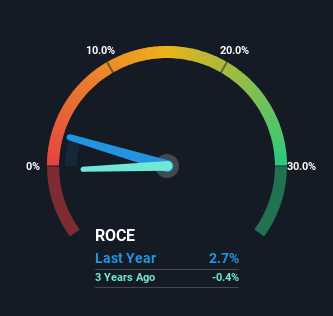- India
- /
- Hospitality
- /
- NSEI:MHRIL
We Like These Underlying Return On Capital Trends At Mahindra Holidays & Resorts India (NSE:MHRIL)

There are a few key trends to look for if we want to identify the next multi-bagger. Firstly, we'd want to identify a growing return on capital employed (ROCE) and then alongside that, an ever-increasing base of capital employed. Basically this means that a company has profitable initiatives that it can continue to reinvest in, which is a trait of a compounding machine. So on that note, Mahindra Holidays & Resorts India (NSE:MHRIL) looks quite promising in regards to its trends of return on capital.
What Is Return On Capital Employed (ROCE)?
For those who don't know, ROCE is a measure of a company's yearly pre-tax profit (its return), relative to the capital employed in the business. Analysts use this formula to calculate it for Mahindra Holidays & Resorts India:
Return on Capital Employed = Earnings Before Interest and Tax (EBIT) ÷ (Total Assets - Current Liabilities)
0.027 = ₹2.0b ÷ (₹98b - ₹25b) (Based on the trailing twelve months to June 2024).
So, Mahindra Holidays & Resorts India has an ROCE of 2.7%. Ultimately, that's a low return and it under-performs the Hospitality industry average of 10%.
Check out our latest analysis for Mahindra Holidays & Resorts India

In the above chart we have measured Mahindra Holidays & Resorts India's prior ROCE against its prior performance, but the future is arguably more important. If you'd like, you can check out the forecasts from the analysts covering Mahindra Holidays & Resorts India for free.
What The Trend Of ROCE Can Tell Us
While in absolute terms it isn't a high ROCE, it's promising to see that it has been moving in the right direction. Over the last five years, returns on capital employed have risen substantially to 2.7%. The company is effectively making more money per dollar of capital used, and it's worth noting that the amount of capital has increased too, by 23%. The increasing returns on a growing amount of capital is common amongst multi-baggers and that's why we're impressed.
Our Take On Mahindra Holidays & Resorts India's ROCE
To sum it up, Mahindra Holidays & Resorts India has proven it can reinvest in the business and generate higher returns on that capital employed, which is terrific. And with the stock having performed exceptionally well over the last five years, these patterns are being accounted for by investors. In light of that, we think it's worth looking further into this stock because if Mahindra Holidays & Resorts India can keep these trends up, it could have a bright future ahead.
Since virtually every company faces some risks, it's worth knowing what they are, and we've spotted 3 warning signs for Mahindra Holidays & Resorts India (of which 1 can't be ignored!) that you should know about.
While Mahindra Holidays & Resorts India may not currently earn the highest returns, we've compiled a list of companies that currently earn more than 25% return on equity. Check out this free list here.
New: Manage All Your Stock Portfolios in One Place
We've created the ultimate portfolio companion for stock investors, and it's free.
• Connect an unlimited number of Portfolios and see your total in one currency
• Be alerted to new Warning Signs or Risks via email or mobile
• Track the Fair Value of your stocks
Have feedback on this article? Concerned about the content? Get in touch with us directly. Alternatively, email editorial-team (at) simplywallst.com.
This article by Simply Wall St is general in nature. We provide commentary based on historical data and analyst forecasts only using an unbiased methodology and our articles are not intended to be financial advice. It does not constitute a recommendation to buy or sell any stock, and does not take account of your objectives, or your financial situation. We aim to bring you long-term focused analysis driven by fundamental data. Note that our analysis may not factor in the latest price-sensitive company announcements or qualitative material. Simply Wall St has no position in any stocks mentioned.
About NSEI:MHRIL
Mahindra Holidays & Resorts India
Operates in the leisure hospitality sector.
Proven track record and fair value.

